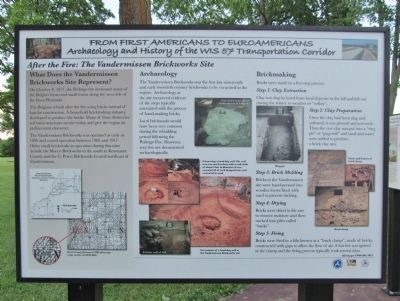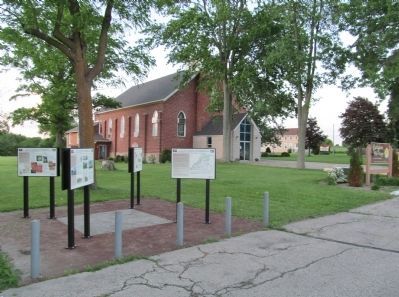Namur in Door County, Wisconsin — The American Midwest (Great Lakes)
After the Fire: The Vandermissen Brickworks Site
From First Americans to Euroamericans
— Archaeology and History of the WIS 57 Transportation Corridor —
Inscription.
What Does the Vandermissen Brickworks Site Represent?
On October 8, 1871, the Peshtigo fire destroyed many of the Belgian farms and small towns along the west side of the Door Peninsula.
The Belgians rebuilt after the fire using bricks instead of logs for construction. A household brickmaking industry developed to produce the bricks. Many of these distinctive red brick structures survive today and give the region its architectural character.
The Vandermissen Brickworks was operated as early as 1899 and ceased operation between 1905 and 1917. Other small brickworks in operation during this time include the Macco Brickworks to the south in Kewaunee County and the G. Peters Brickworks located northeast of Vandermissen.
Archaeology
The Vandermissen Brickworks was the first late 19th and early twentieth century brickworks to be excavated in the region. Archaeology at the site recovered evidence of the steps typically associated with the process of hand-making bricks.
Local brickworks would have been very common during the rebuilding period following the Peshtigo Fire. However, very few are documented archaeologically.
Brickmaking
Bricks were made in a five-step process.
Step 1: Clay Extraction
Clay was dug by hand from local deposits in the fall and left out during the winter to weather or "soften".
Step 2: Clay Preparation
Once the clay had been dug and softened, it was ground and screened. Then the raw clay was put into a "ring pit" or "pug mill" and sand and water were added to produce a brick clay mix.
Step 3: Brick Molding
Bricks at the Vandermissen site were hand-pressed into wooden forms lined with sand to prevent sticking.
Step 4: Drying
Bricks were dreid in the sun to remove moisture and then stacked into piles called "hacks".
Step 5: Firing
Bricks were fired in a kiln known as a "brick clamp", made of bricks, constructed with gaps to allow the flow of air. A hot fire was ignited in the clamp and the firing process typically took several days.
(All images UWM-ARL 2012)
logos of United States Department of Transportation, University of Wisconsin–Milwaukee, Wisconsin Department of Transportation
Erected 2012 by U.S. Department of Transportation, University of Wisconsin–Milwaukee, Wisconsin Department of Transportation.
Topics. This historical marker is listed in these topic lists: Industry & Commerce • Man-Made Features. A significant historical date for this entry is October 8, 1871.
Location. 44° 44.064′ N, 87° 40.02′
W. Marker is in Namur, Wisconsin, in Door County. Marker is on County Road DK east of County Road N, on the left when traveling east. Marker is immediately southwest of the Belgian Heritage Center, formerly Our Lady of the Snows Church. Touch for map. Marker is at or near this postal address: 1255 County Road DK, Brussels WI 54204, United States of America. Touch for directions.
Other nearby markers. At least 8 other markers are within 3 miles of this marker, measured as the crow flies. The Fire of 1871 and Williamsonville: A 19th Century Euroamerican Settlement in Door County (here, next to this marker); Architecture and History in the WIS 57 Project Area (here, next to this marker); Namur and the Norbertine Fathers: Community, Education, and Religion among Belgian-Americans (here, next to this marker); Historic Euroamerican Settlement of the Door Peninsula (here, next to this marker); Transportation Archaeology on the WIS 57 Project (here, next to this marker); The WIS 57 Reconstruction Project in Brown, Kewaunee, and Door Counties (here, next to this marker); Belgian Settlement in Wisconsin (within shouting distance of this marker); The Brussels Cemetery Grotto (approx. 2˝ miles away). Touch for a list and map of all markers in Namur.
More about this marker. photo and map captions, clockwise:
• Lime processing area at Vandermissen brickworks
• Uncovering a hand dug well: The well was over ten feet deep with a well shaft of about 3 feet in diameter. It was constructed of rock dumped into a pit excavated in sand.
• Ring pit
• Doors and frames of brick clamp
• Brick clamp
• Excavations of a hand-dug well at the Vandermissen Brickworks site
• Exterior wall of well
• Door County Democrat 1905 plat map (copy on file at UWM-ARL.)
• Historic Brickworks, WIS 57 Reconstruction, Kewaunee and Door Counties, Wisconsin
Also see . . . Brick by Brick: A Comparative pXRF Analysis of Brickworks and Structures. University of Wisconsin-Milwaukee. (Submitted on January 11, 2015.)
Credits. This page was last revised on October 14, 2021. It was originally submitted on January 11, 2015, by Keith L of Wisconsin Rapids, Wisconsin. This page has been viewed 675 times since then and 16 times this year. Photos: 1, 2. submitted on January 11, 2015, by Keith L of Wisconsin Rapids, Wisconsin.

